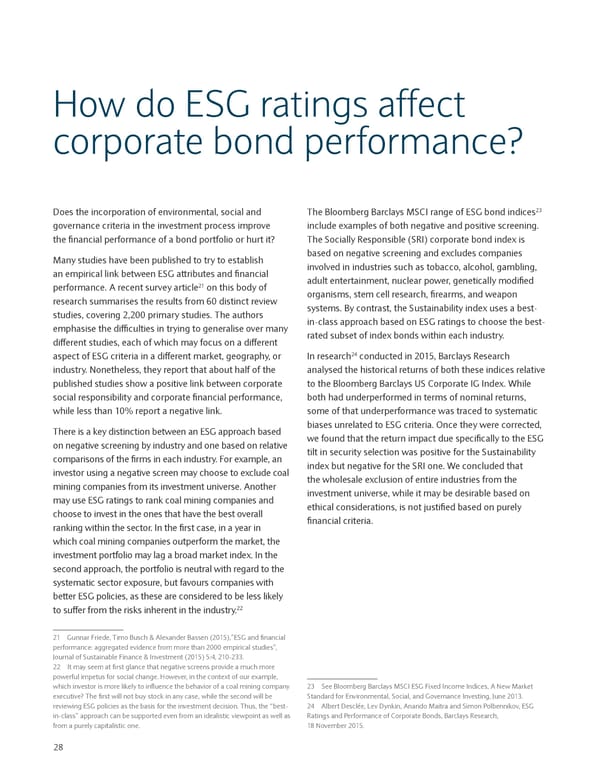How do ESG ratings affect corporate bond performance? 23 Does the incorporation of environmental, social and The Bloomberg Barclays MSCI range of ESG bond indices governance criteria in the investment process improve include examples of both negative and positive screening. the financial performance of a bond portfolio or hurt it? The Socially Responsible (SRI) corporate bond index is Many studies have been published to try to establish based on negative screening and excludes companies an empirical link between ESG attributes and financial involved in industries such as tobacco, alcohol, gambling, 21 on this body of adult entertainment, nuclear power, genetically modified performance. A recent survey article organisms, stem cell research, firearms, and weapon research summarises the results from 60 distinct review systems. By contrast, the Sustainability index uses a best- studies, covering 2,200 primary studies. The authors in-class approach based on ESG ratings to choose the best- emphasise the difficulties in trying to generalise over many rated subset of index bonds within each industry. different studies, each of which may focus on a different aspect of ESG criteria in a different market, geography, or 24 conducted in 2015, Barclays Research In research industry. Nonetheless, they report that about half of the analysed the historical returns of both these indices relative published studies show a positive link between corporate to the Bloomberg Barclays US Corporate IG Index. While social responsibility and corporate financial performance, both had underperformed in terms of nominal returns, while less than 10% report a negative link. some of that underperformance was traced to systematic There is a key distinction between an ESG approach based biases unrelated to ESG criteria. Once they were corrected, on negative screening by industry and one based on relative we found that the return impact due specifically to the ESG comparisons of the firms in each industry. For example, an tilt in security selection was positive for the Sustainability investor using a negative screen may choose to exclude coal index but negative for the SRI one. We concluded that mining companies from its investment universe. Another the wholesale exclusion of entire industries from the may use ESG ratings to rank coal mining companies and investment universe, while it may be desirable based on choose to invest in the ones that have the best overall ethical considerations, is not justified based on purely ranking within the sector. In the first case, in a year in financial criteria. which coal mining companies outperform the market, the investment portfolio may lag a broad market index. In the second approach, the portfolio is neutral with regard to the systematic sector exposure, but favours companies with better ESG policies, as these are considered to be less likely 22 to suffer from the risks inherent in the industry. 21 Gunnar Friede, Timo Busch & Alexander Bassen (2015),”ESG and financial performance: aggregated evidence from more than 2000 empirical studies”, Journal of Sustainable Finance & Investment (2015) 5:4, 210-233. 22 It may seem at first glance that negative screens provide a much more powerful impetus for social change. However, in the context of our example, which investor is more likely to influence the behavior of a coal mining company 23 See Bloomberg Barclays MSCI ESG Fixed Income Indices, A New Market executive? The first will not buy stock in any case, while the second will be Standard for Environmental, Social, and Governance Investing, June 2013. reviewing ESG policies as the basis for the investment decision. Thus, the “best- 24 Albert Desclée, Lev Dynkin, Anando Maitra and Simon Polbennikov, ESG in-class” approach can be supported even from an idealistic viewpoint as well as Ratings and Performance of Corporate Bonds, Barclays Research, from a purely capitalistic one. 18 November 2015. 28
 Sustainable Investing and Bond Returns Page 31 Page 33
Sustainable Investing and Bond Returns Page 31 Page 33